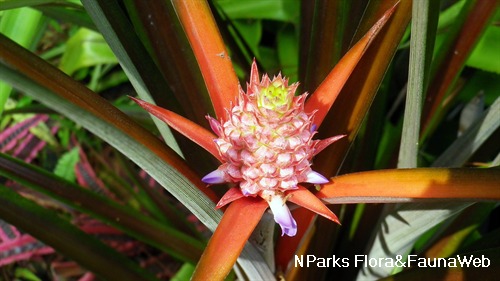
Back
Ananas comosus (L.) Merr.
| Family Name: | Bromeliaceae |
| Synonyms: | Ananas sativus, Bromelia comosa |
| Common Name: | Pineapple, Nanas |
Name
Classifications and Characteristics
| Plant Division | Angiosperms (Flowering Seed Plants) (Monocotyledon) |
|---|---|
| Plant Growth Form | Herbaceous Plant |
| Lifespan (in Singapore) | Biennial |
| Mode of Nutrition | Autotrophic |
| Maximum Height | 0.5 m to 1.5 m |
Biogeography
| Native Distribution | Tropical America |
|---|---|
| Native Habitat | Terrestrial |
| Local Conservation Status | Non-native (Horticultural / Cultivated Only) |
Description and Ethnobotany
| Growth Form | A herb 50 to 150cm in height. |
|---|---|
| Foliage | The leaves are sword-shaped and rigid with a spiny leaf margin and a grooved upper surface. The leaves are arranged in a rosette. |
| Flowers | The bisexual flowers are borne on a compact inflorescence and are sessile. Each flower consists of 3 sepals and petals which encloses 6 stamens and a 3 branched stigma. |
| Fruit | The fruit is an aggregate fruit formed by the fusing of the individual fruits and is cylindrical in shape. The hard rind is formed by the persistent sepals and floral bracts which have also been fused together. |
| Cultivation | It is best cultivated under full sun at temperatures of 23 to 32°C. The plant is tolerant to drought and acidic soils. It is best planted in dry, sandy loam with the addition of organic matter. Growing medium should be have good drainage so as to prevent root rot. |
| Ethnobotanical Uses | Edible Plant Parts : Edible Fruits Food (Fruit or Vegetable): The fruit is best eaten fresh or canned. It is also used to make pineapple juice. The fruits are also used to make jam or for crystallized fruit. |
Landscaping Features
| Desirable Plant Features | Ornamental Foliage, Ornamental Fruits |
|---|
Plant Care and Propagation
| Light Preference | Full Sun |
|---|---|
| Water Preference | Little Water |
| Rootzone Tolerance | Drought Tolerant |
| Propagation Method | Sucker |
Foliar
| Mature Foliage Colour(s) | Green |
|---|---|
| Foliar Type | Simple / Unifoliate |
| Foliar Arrangement Along Stem | Rosulate / Rosette |
| Foliar Attachment to Stem | Sessile |
| Foliar Margin | Spiny |
| Leaf Area Index (LAI) for Green Plot Ratio | 3.5 (Shrub & Groundcover - Monocot) |
Floral (Angiosperm)
| Flower & Plant Sexuality | Bisexual Flowers |
| Flower Grouping | Cluster / Inflorescence |
|---|---|
| Flower Location | Terminal |
| Inflorescence Type | Spike |
Fruit, Seed and Spore
| Mature Fruit Colour(s) | Orange, Yellow / Golden |
|---|---|
| Fruit Classification | Aggregate Fruit (Syncarp) |
| Fruit Type | Fleshy Fruit |
Image Repository
Others
| Master ID | 367 |
|---|---|
| Species ID | 1663 |
| Flora Disclaimer | The information in this website has been compiled from reliable sources, such as reference works on medicinal plants. It is not a substitute for medical advice or treatment and NParks does not purport to provide any medical advice. Readers should always consult his/her physician before using or consuming a plant for medicinal purposes. |








